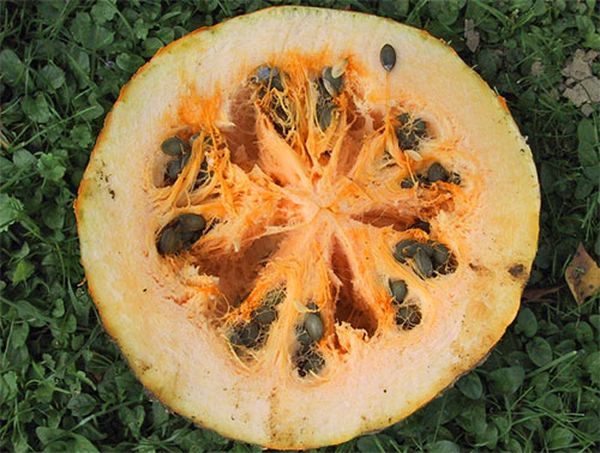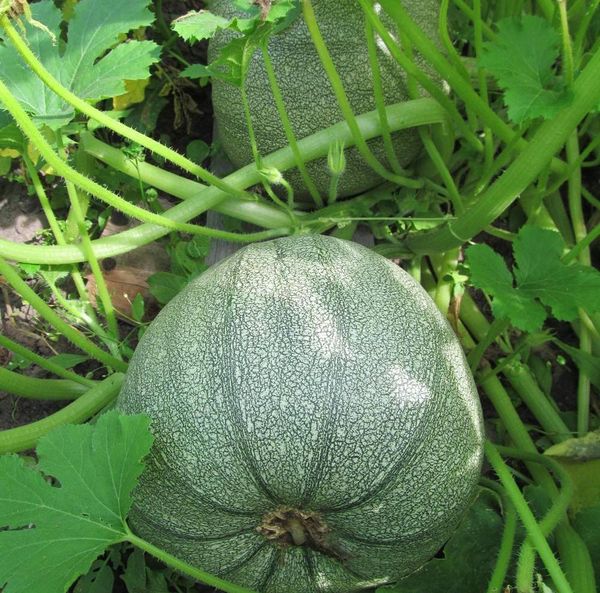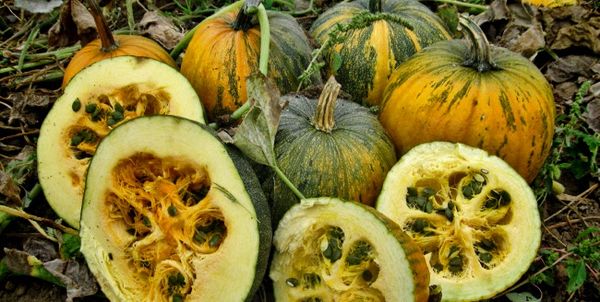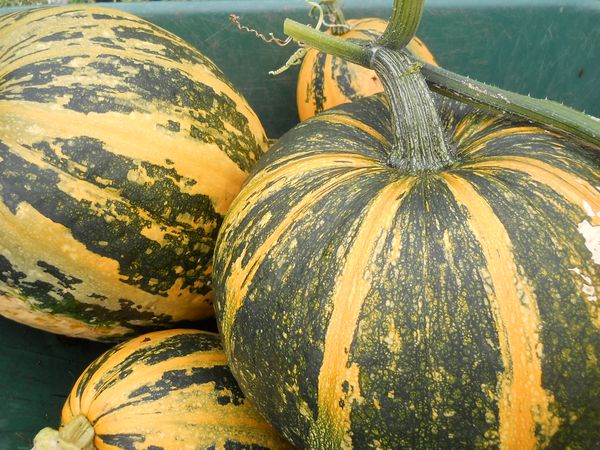Pumpkin is a popular melon crop grown in different countries of the world. Vegetable gained its popularity due to the content of a large amount of vitamins. Among a wide variety of varieties, the most popular is the hard-bodied pumpkin Golosemyanka.
Table of contents
- Description and characterization of the hard pumpkin Golosemyanka
- Breeding history and region of growth
- The advantages and disadvantages of the variety
- Soil preparation before planting
- Planting seeds in open ground
- Growing seedlings
- Growing conditions and care
- Peculiarities of this variety
- Diseases and pests
Description and characterization of the hard pumpkin Golosemyanka
Golosemyanka bulldog has its name due to bare seeds. Seeds are covered with a thin film rich in fiber.
Pumpkin according to the characteristic has an oblong shape with a hard but thin skinned, dark green color with whitish spots. The flesh is light yellow with a slightly sweet taste.
The shrub plant has powerful roots extending 3-5 meters into the ground. The bush forms up to 80 female and up to 400 male flowers. The first male flowers are formed at the age of 20-30 days, and after 7 days female flowers begin to bloom, they appear on a 3-10 leaf node.

According to the description, the gymnast pumpkin, on the bush is formed from 1 to 4 fruits.
Breeding history and region of growth
Gymnosperm gourd, was bred in the Austrian city of Styria, in 1880. About this variety in Russia learned in 1911. This vegetable is grown in all corners of the world, due to the high oil content in the bare seeds.
The advantages and disadvantages of the variety
The advantages include:
- Seeds do not have a dense shell
- Contains 50% oil
- Harvesting is carried out for 3-4 months after planting seeds
- Sort resistant to temperature changes

Soil preparation before planting
To obtain a rich harvest you need to carefully approach the preparation of the soil. Pumpkin grows well on the beds where it used to grow:
- Corn
- Legumes
- Potatoes
- Winter wheat
Can not be planted seedlings or seeds where they grew:
- Tomatoes
- Carrot
- Cucumbers
- Zucchini
This is due to the fact that these cultures have the same disease, as well as these plants can not be grown next door.

Golosemyanka can be grown rassadnym and seedless way. Rassadny method - allows you to harvest much earlier.
Planting seeds in open ground
Seeds are sown in warm (up to 15 degrees) ground. The distance between the rows should be not less than 2 meters. Prepare pits with a diameter of 30 cm for planting. The well is shed with warm water and fertilized with complex fertilizers.All carefully dug up to a depth of 20 cm, and then planted 3-4 seeds.
The interval between the holes is 3-4 cm, and the depth of the bookmark is 5-6 cm. After germination, 2 sturdier plants are left in the hole.
Before planting, seeds warm up 10 hoursat a temperature of 40 degrees.
Growing seedlings
- Pumpkin seeds Golosemyanka
- Growing seedlings is best done in peat pots.
Pumpkin seeds Golosemyanka planted in peat pots size 10x10. Sowing seeds produce in late Aprilat a depth of 3 cm.
Pots filled with nutrient soil moistened with a weak solution of potassium permanganate. With proper care, the first shoots appear after a week. During the growth of seedlings, it is watered with warm, settled water.
When the plant is formed 4-5 sheets, it can be put on a permanent place. Planting of seedlings produced after spring frosts, in the evening. A week later, seedlings take root and starts to grow intensively.
Growing conditions and care
The first fertilizing with mineral or organic fertilizers is carried out a week after transplanting. From mineral dressings optimally suited nitroammophoska, and from organic - rotted horse or cow dung.
The second is carried out at the beginning of flowering. The third - in the period of fruiting.

Water the plant in the morning or evening, to prevent leaf burn. In hot weather, watering is carried out 2 times a day.
After planting and before flowering soil moisture should be 70%. During flowering and fruit formation - 80%. During the ripening period - 70%. 14 days before harvesting, watering is stopped.
After each watering, the soil loosen and spud, so as not to form an earth crust, which will impede the access of air to the roots.
In August, the plant produces lateral shoots that pinch, as they take a lot of nutrients from the plant.
Bush needed mulch, for preservation of moisture and preservation of fruits from rotting.
Three weeks before the end of plant growth, the top and side shoots pinch. This procedure is carried out in order that all nutrients are directed to the ripening of fruits.
The degree of ripening of fruits is determined by the drying of the leaves, the stem and the shoots.

Peculiarities of this variety
- The seeds of Golosemyanka are covered with a thin film rich in fiber.
- The precocity of the variety is determined by the location of the female flower, the lower the first female flowers, the sooner the variety.
- Fruits are round and cylindrical, reaching up to 10 kg.
- In pumpkin, you can use seeds, pulp and young shoots for therapeutic purposes.
- Because of the low calorie content, it is recommended to use it in diets as a dietary product.
- Resistance to temperature changes.
Diseases and pests
Among the diseases often occurs:
- Fruit rot - occurs when the fruit touches the wet ground.
- Mealy dew - with high humidity.
Pests can attack a pumpkin plant - insects:
- Gourd Aphid
- Wireworm

At the first signs of disease, the plants are sprayed fungicides. It is better to prevent the disease than to treat it. Therefore, it is necessary to observe preventive measures:
- Crop rotation
- Spend soil liming before planting, weeding and loosening around the bush
- Monitor the temperature, humidity and soil
- After harvesting it is necessary to completely remove plant residues
Growing pumpkin varieties Golosemyanka sluggardly, is not much different from the cultivation of other varieties. But it must be remembered that: it is more thermophilic and it is better to plant it in a seedling manner, since bare seeds can rot in the ground before germination.


